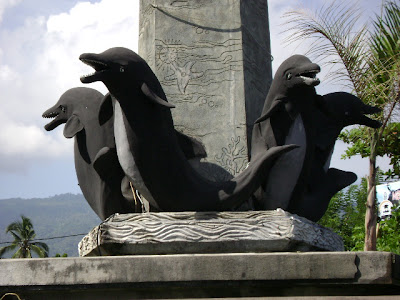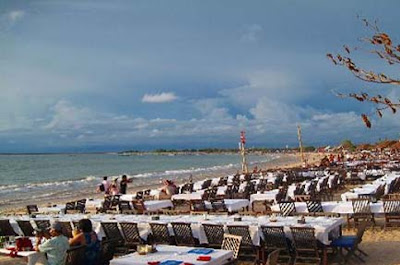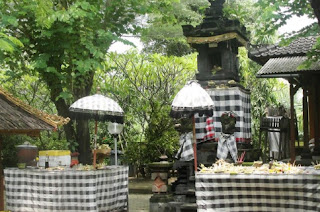"This blog offers essential insights into Bali’s top tourist spots and best hotels, helping travelers plan their perfect visit."
Tuesday, 30 April 2013
Jatiluwih village
Agung Mountain and Besakih Temple
Monday, 29 April 2013
Amed Beach
 |
| Amed Beach |
Ponjok Batu Temple
Ponjok Batu Temple is a sacred site located on a rocky headland, radiating natural beauty with its rock crevices, flourishing frangipani trees, and lush shrubs. In Balinese, "Ponjok Batu" means "Rocky Headland," reflecting the geographic features of this location. This temple serves not only as a place of worship for the Balinese Hindu community but also as a captivating natural tourist destination, combining both spiritual depth and scenic charm.
The temple functions as a public sanctuary where both locals and visitors come to offer prayers and seek blessings for protection. Ponjok Batu Temple is an essential part of Bali's rich cultural and spiritual heritage, which remains well-preserved to this day. Its serene and sacred atmosphere provides inner peace and tranquility to everyone who visits, whether for spiritual reasons or simply to enjoy the surrounding natural beauty.
From the temple's front courtyard, a road connects Singaraja to Amlapura, bordering the temple area. To the north, the vast, calm Java Sea stretches out, offering a soothing view that brings peace of mind and a sense of reflection for visitors. This tranquil seascape often inspires those seeking peace or a moment of contemplation amidst the stunning natural surroundings.
The beauty of the temple is further enhanced by the presence of ancient trees growing on the surrounding hills. These trees not only add to the natural charm but also create a cool, shady environment for visitors. Several natural springs are scattered around the temple area, which the local community uses for their daily needs, making the temple an integral part of local life.
Ponjok Batu Temple is located approximately 24 kilometers east of Singaraja, in the village of Pacung, Tejakula District. Its location in a rural setting adds to its appeal as a peaceful place, far from the bustling city life. The entire temple structure is made from natural stone found in the surrounding area, blending seamlessly with the environment. This unique architectural design sets Ponjok Batu Temple apart from other temples in Bali, with a strong connection to nature and traditional elements.
In addition to being a place of worship, Ponjok Batu Temple is also a must-visit natural tourist destination. The combination of natural beauty, peaceful surroundings, and the spiritual values within the temple creates a holistic experience for visitors. Whether they come to pray, meditate, or simply enjoy the scenic views, Ponjok Batu Temple offers an experience that touches the heart and pleases the eye.
The temple also attracts tourists interested in learning more about Bali's culture and spirituality. It symbolizes the harmony between humans, nature, and God, in line with the Balinese Hindu philosophy of Tri Hita Karana. With all its charms, Ponjok Batu Temple is a place that should be on the list of anyone seeking the peace and natural beauty of authentic Bali.
Wednesday, 24 April 2013
Medewi Beach
 |
| Medewi Beach |
A beautiful view at sunset. Of which has been reclaimed by the beach, visitors can sit and enjoy the waves and the gentle breeze caresses medewi coast. The road to the beach attractions Medewi is easy. Medewi beach is located approximately 100 meters from the highway Denpasar-Gilimanuk which is a rural area medewi, Pekutatan district, Jembrana regency. On the way to the beach Medewi attractions, you will be presented with a view of rice fields looked lined the shores of the beach. If farmers are harvesting, the scenery will look more attractive. Tourism accommodation has been found here, such as; hotel, restaurant, parking and public bathrooms, as well as there's a pool.
Tuesday, 23 April 2013
Goa Gajah Temple
 |
| Goa Gajah Temple |
Monday, 22 April 2013
Padanggalak beach
 |
| Padanggalak Beach |
Banyuwedang Hot springs
Friday, 19 April 2013
Tirta Empul Temple of Tampaksiring
 |
| Tirta Empul Temple |
 |
| Tirta Empul holy shower |
Lake Buyan and Lake Tamblingan
 |
| The Buyan lake |
 |
| The Tamblingan lake |
Lake Buyan and Lake Tamblingan: Serene Gems of Sukasada
Lake Buyan and Lake Tamblingan, nestled in the Sukasada district just 21 km south of Singaraja City, are easily accessible via the Denpasar-Singaraja road. Situated at an altitude of approximately 1,000 meters above sea level, these lakes are renowned for their cool, refreshing climate, which can become quite chilly at night.
Tamblingan Lake is conveniently reached via a junction leading to Munduk Village, allowing visitors to enjoy stunning panoramic views of both lakes along the way. This scenic route enhances the experience, making the journey to the lakes just as enjoyable as the destination itself.
Facilities around the lakes include ample parking near the shoreline, where visitors can also rent boats for fishing or leisurely exploration. Additionally, accommodation options are available for those wishing to extend their stay and fully immerse themselves in this tranquil environment.
The majority of tourists visiting Lake Buyan and Lake Tamblingan tend to be international travelers, often arriving in private vehicles or with dedicated drivers. This creates a more personalized experience as they explore the breathtaking natural surroundings.
Strategically located, Lake Buyan and Lake Tamblingan are flanked by three renowned attractions: the iconic Ulun Danu Beratan Temple, the stunning Gitgit Waterfalls, and the beautiful Lovina Beach. This prime location makes the lakes an ideal stop for those exploring Bali’s rich cultural and natural offerings, providing a perfect blend of relaxation and adventure in one unforgettable visit.
Wednesday, 17 April 2013
Pulaki Temple
 |
| Pulaki Temple |
Tourism in Lovina Beach
 |
| Statues of Dolphins in Lovina Beach |
 |
| Sunrise at Lovina Beach |
Alas Kedaton Tourist Sites
 |
| Alas Kedaton Temple |
Tuesday, 16 April 2013
Toya Bungkah Region
Sanur Beach
 |
| Sanur Beach |
Sanur Beach, located in the vibrant city of Denpasar, is one of Bali's most iconic coastal destinations, renowned since the Dutch colonial era for its stunning beauty and cultural significance. The beach area is home to several famous stretches of sand, including Sunrise Beach, Sanur Beach itself, and Sindhu Beach, each offering breathtaking views of the sunrise. On clear days, the majestic backdrop of Mount Agung enhances the beauty of these picturesque beaches, creating a stunning visual experience.
Visitors can find charming gazebos along the beach, perfect for relaxation while enjoying the tranquil morning sunrise. The colorful fishing boats lined up along the shore add to the beach's allure, providing a delightful sight for travelers seeking a taste of local life.
Sanur Beach offers a scenic path ideal for jogging or leisurely strolls, allowing you to breathe in the fresh morning air as you take in the stunning coastal views. Spanning approximately 6 kilometers, this picturesque path stretches from Sanur Beach to Padanggalak Beach, making it perfect for those looking to explore the coastline on foot.
When hunger strikes, visitors need not worry, as numerous food stalls and cafes dot the coastline, serving delicious local cuisine from as early as 7 AM. You can enjoy a hearty meal or a refreshing drink while soaking up the serene beach atmosphere.
For those considering a stay at Sanur Beach, a variety of accommodation options are available to suit all budgets. From affordable guesthouses to luxurious villas priced in the hundreds of dollars, you'll find the perfect place to unwind after a day of exploration. Additionally, many hotels line the eastern and southeastern shores, providing convenient access to the beach and local attractions.
Sanur Beach is also a hub for water recreation, offering an array of exciting activities such as diving, snorkeling, canoeing, surfing, jet skiing, and parasailing. Whether you’re seeking adventure or relaxation, Sanur Beach has something for everyone.
Experience the charm of Sanur Beach, where stunning sunrises, rich culture, and a vibrant atmosphere come together to create an unforgettable Bali experience. Book your stay today and immerse yourself in the beauty of this enchanting destination!
Monday, 15 April 2013
Jimbaran and Kedonganan Beach
 |
| Kedonganan Sea Food |
 |
| Sunset at Jimbaran |
Friday, 12 April 2013
Uluwatu Temple
 |
| Sunset at Uluwatu Temple |
 |
| View at Uluwatu Temple |
 |
| Cliff at Uluwatu Temple |
Nusa Dua Bali Tourism Area
 |
| Tanjung Benoa @ Nusa Dua Bali |
 |
| Parasailing |
 |
| Flying Fish |
 |
| Banana Boat |
Wednesday, 10 April 2013
Garuda Wisnu Kencana statue
 |
| Garuda Wisnu Kencana statue |
The Garuda Wisnu Kencana (GWK) statue, located in Bukit Unggasan, Jimbaran, Bali, is one of Indonesia’s most iconic landmarks. Designed by renowned sculptor I Nyoman Nuarta, this masterpiece is currently being developed as a cultural park and stands as a significant symbol of tourism for both Bali and Indonesia. The statue depicts Lord Vishnu, one of Hinduism's principal deities, as the protector of the universe, riding on the mythical bird Garuda, a symbol of courage and loyalty.
With a towering height of 140 meters, the Garuda Wisnu Kencana statue is projected to become a major focal point, visible from as far as 20 kilometers away. Visitors can enjoy views of this magnificent statue from well-known tourist areas such as Kuta, Sanur, Nusa Dua, and even Tanah Lot. GWK stands as a symbol of environmental preservation and global conservation, embodying the harmonious relationship between humanity and nature.
"Garuda Wisnu Kencana" translates to "Garuda, the vehicle of Vishnu," and the statue is situated atop a limestone plateau, overlooking Bali's scenic southern coast. Located just 25 km from Denpasar and 15 km from Ngurah Rai International Airport, GWK Cultural Park offers a unique window into Balinese art and culture, set against a stunning natural backdrop. The park spans over 250 hectares, providing visitors with a comprehensive experience of Bali's rich cultural heritage and breathtaking landscapes.
At GWK Cultural Park, visitors can explore not only the monumental statue but also enjoy various cultural activities. The park is equipped with modern facilities, ensuring a comfortable and enriching visit. One of the park’s highlights is the Amphitheater, which boasts a seating capacity of 800 and state-of-the-art acoustics. This venue is ideal for cultural performances, allowing guests to immerse themselves in Balinese arts in an unforgettable setting.
As a cultural icon, GWK is envisioned to symbolize the balance between nature and human existence. In Hindu beliefs, Lord Vishnu represents the protector of the universe, and Garuda, his devoted companion, symbolizes selfless service. Together, they embody the values of environmental protection and the preservation of nature.
Construction of the Garuda Wisnu Kencana statue began in 1997. Though the statue’s completion is ongoing, key components like the upper body of Lord Vishnu, Garuda, and Vishnu's hands have already been completed. The finished statue is set to be one of the largest and most impressive in the world, drawing visitors from all corners of the globe.
When visiting Bali, GWK Cultural Park is a must-see destination that offers a blend of cultural enrichment and spectacular views. Whether you’re interested in exploring Balinese culture, enjoying panoramic vistas, or attending world-class performances, this cultural park offers something for everyone. By booking your stay near GWK on Agoda, you can easily access this awe-inspiring landmark and explore Bali’s other top attractions. Agoda provides a wide range of accommodations near GWK, from luxurious resorts to budget-friendly hotels, ensuring you find the perfect place to stay. Don’t miss out on the chance to witness Bali’s iconic cultural symbol—book your trip to Garuda Wisnu Kencana through Agoda today!
Tuesday, 9 April 2013
Peti Tenget Temple
 |
| Peti Tenget Temple |
5 hotel tepi pantai terbaik di area Jimbaran, Bali
Berikut adalah 5 hotel tepi pantai terbaik di area Jimbaran, Bali, yang menawarkan kenyamanan dan pemandangan indah: Four Seasons Resort Ba...
-
The hot springs are located in the village Penatahan, Penebel District, approximately 13 km away from the city to the north tab...
-
Sunrise at Amed beach Amed Beach is located on the eastern part of Bali, precisely in the Abang district, Karangasem Regency. Su...
-
Brahmavihara Arama Brahmavihara-Arama, better known by the name of Buddha banjar monastery which is the biggest Buddha monastery in...









